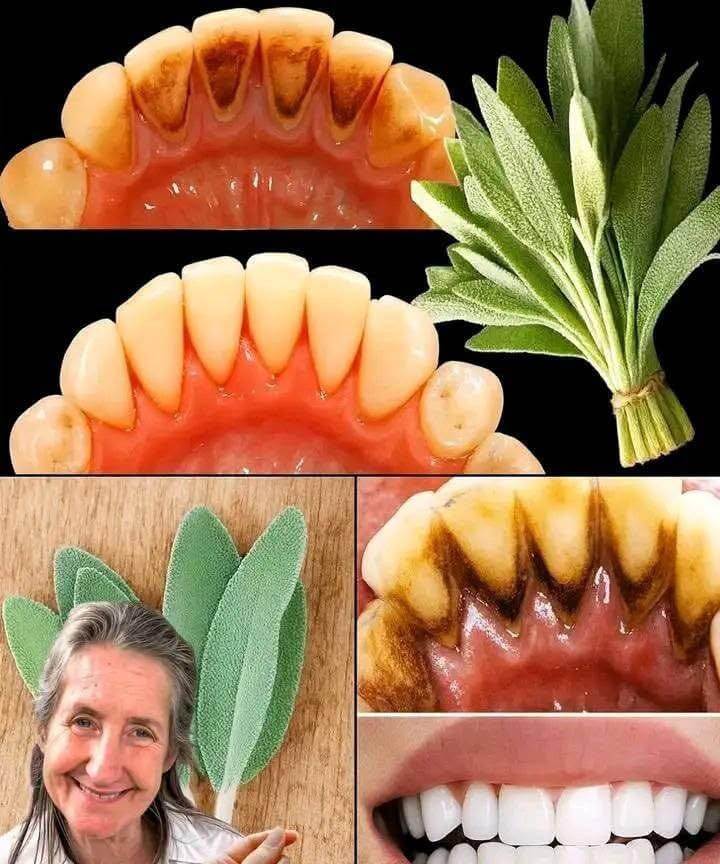Remove Tartar and Whiten Your Teeth Naturally with Sage Leaves
Introduction
Sage (Salvia officinalis) is a medicinal herb rich in natural antimicrobial, anti-inflammatory, and astringent properties. Ancient cultures — including the Greeks and Romans — used sage leaves as a natural tooth cleanser and breath freshener.
This simple natural method can help:
Remove tartar and plaque buildup
Gently whiten teeth over time
Kill bacteria that cause bad breath
Soothe gum inflammation and strengthen teeth
Unlike harsh chemical whiteners, sage is gentle, herbal, and safe when used properly.
Ingredients
A handful (6–8) fresh sage leaves or 1 tablespoon dried sage
1 teaspoon baking soda (optional, for extra whitening)
1 teaspoon coconut oil or olive oil (optional, for smoother paste)
A few drops of lemon juice (optional, adds freshness and mild bleaching effect)
Instructions
Prepare the Sage
Wash sage leaves thoroughly to remove any dirt or dust.
If using fresh leaves, pat them dry and chop finely or crush them using a mortar and pestle.
For dried sage, grind into a fine powder.
Make the Mixture
You can use sage in two ways — as a powder rub or herbal paste.
Option 1: Sage Powder Rub
Spread fresh or dried sage leaves on a tray.
Let them dry fully under sunlight for 1–2 days.
Once crisp, grind into a fine powder.
Store in a clean, dry container.
To use — dip your wet toothbrush into the powder and gently brush for 2–3 minutes.
Option 2: Sage Whitening Paste
In a small bowl, combine crushed sage with a few drops of lemon juice and coconut oil.
Add baking soda if you prefer extra cleaning power.
Mix into a smooth paste consistency.
Apply the mixture on your teeth and gently brush for 2–3 minutes.
Rinse thoroughly with lukewarm water.
Finish and Rinse
After brushing, rinse your mouth well with warm water.
Optionally, rub a fresh sage leaf directly on your teeth and gums for 30–60 seconds for an extra polish and fresh aroma.
Tips
Use this 2–3 times a week — not daily, as overuse of baking soda or lemon may weaken enamel.
Combine with a good oral hygiene routine (regular brushing and flossing).
Always use soft-bristled toothbrushes for gentle cleaning.
Replace sage leaves regularly — fresh herbs give better results.
Health & Beauty Benefits
Removes Tartar and Plaque
Sage has natural abrasive and antibacterial compounds that break down plaque layers and prevent tartar buildup.
Whitens Teeth Naturally
Regular use gently polishes stains caused by coffee, tea, or smoking — without synthetic bleaching agents.
Kills Bacteria and Freshens Breath
Its antimicrobial oils help kill odor-causing bacteria and leave your mouth naturally fresh.
Soothes Gums and Reduces Inflammation
Sage’s anti-inflammatory and antioxidant compounds calm irritated gums and strengthen oral tissue.
Supports Overall Oral Health
Rich in calcium and flavonoids, sage supports healthy teeth and fights infection naturally.
Precautions
Avoid brushing too hard — it can erode enamel.
If you use lemon juice, limit use to once a week due to acidity.
Always rinse well to remove any residue.
People with sensitive teeth or gum disease should consult a dentist before trying herbal remedies.
Sage should not replace regular dental check-ups or professional cleanings.
Final Thoughts
Sage leaves are one of nature’s best-kept secrets for a brighter smile and cleaner mouth. With their natural oils and cleansing compounds, they effectively help reduce tartar and bring back your teeth’s natural shine.Used regularly and safely, this gentle herbal method can help you maintain a healthy, white, and fresh-smelling smile — the natural way.

